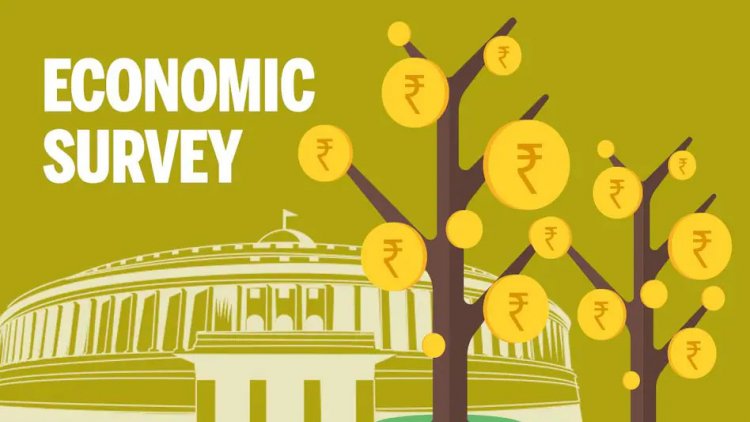Economic Survey 2022-23: Highlights
STORIES, ANALYSES, EXPERT VIEWS

Every year, the Economic Survey is presented a day before the Union Budget. It presents an overview of the economy as well as the way forward. This year's Survey has been prepared by Principal Economic Adviser Sanjeev Sanyal, in absence of a Chief Economic Adviser.
GDP projected at 9 per cent: The economic survey 2021-22, tabled by Finance Minister Nirmala Sitaraman in Parliament Monday, expects the economy to grow by 8-8.5 per cent in the upcoming financial year, on the back of a 9.2 per cent expansion in 2021-22. The Survey’s projections appear conservative when compared to recent assessments of the IMF, which has pegged the economy to grow at 9 per cent, or the World Bank which expects it to grow at 8.7 per cent.
Growth in 2022-23 will be supported by widespread vaccine coverage, gains from supply-side reforms and easing of regulations, robust export growth, and the availability of fiscal space to ramp up capital spending.
Pranav Mukul (Principal Correspondent, The Indian Express) summarises the Economic Survey in other crucial areas as below.
Fiscal deficit target of 6.8%: The Survey notes that buoyant tax revenues and government policies have created “headroom for taking up additional fiscal policy interventions”. Stressing the need to continue the focus on capital expenditure, it has indicated that the government is on course to achieve the fiscal deficit target of 6.8% of GDP for the current year. Revenue receipts of the Centre during April-November 2021 have gone up by 67.2% (YoY) as against an estimated growth of 9.6% in the 2021-22 Budget Estimates. The estimated tax collections provide the cushion to support growth next year.
Macro-economic stability: Future risks for the economy include inflation, global liquidity measures, and rising energy prices.
While assuring that when it comes to macro-economic stability, India is better placed than it was at the time of the global financial crisis and the taper tantrum, what is less clear is the extent to which the recovery will heal the scars induced by the pandemic in the near term.
Inflation: The Survey notes that while India’s CPI inflation — 5.2% in 2021-22 (April-December) — is within the targeted tolerance band, WPI inflation has been running in double digits. This is partly due to base effects; however, “India does need to be wary of imported inflation, especially from elevated global energy prices”.
Global uncertainty: While the sizeable accretion of foreign exchange reserves — $633.6 billion as of December 31, 2021 — makes India’s external sector resilient for the withdrawal of liquidity measures, the Survey points out that the overall balance of risks for global trade is tilted to the downside.
The biggest downside risk comes from the pandemic, it says, along with longer port delays, higher freight rates, and the shortage of shipping containers and inputs such as semiconductors. Supply-side disruptions, exacerbated by recovery in demand, pose significant risks for global trade.
Energy risks: The report calls for a “diversified mix of sources of energy of which fossil fuels are an important part”, but simultaneously calls for focus on building storage for intermittent electricity generation from solar PV and wind farms to ensure on-demand energy supply.
Supply side reforms: The Survey calls for emphasis on developing a supply-side strategy to deal with the long-term unpredictability of the post-Covid world, emanating mainly from factors such as changes in consumer behaviour, technological developments, geopolitics, climate change, and their potentially unpredictable interactions.
Industrial growth: The industrial sector is likely to record a growth of 11.8% in 2021-22. Although performance slowed during the year, the gradual unlocking of the economy and measures such as the PLI scheme etc. “The pace of this recovery and further growth is likely to continue due to consistent efforts of the government to bring in various structural, fiscal and infrastructural reforms in addition to a slew of measures/schemes like the production linked incentive scheme (PLI) to support industries,” it said.
Public spending: After a slowdown in the first half of the ongoing financial year, capital expenditure by the Centre revived during October-December. During April-November 2021, capital expenditure grew by 13.5% (YoY), with focus in infrastructure-intensive sectors like roads and highways, railways, and housing and urban affairs.
Macro-economic stability: Basis the macro-economic stability indicators, the Survey believes that the Indian economy is “well placed” to take on the challenges of 2022-23. The government’s strategy has been to not pre-commit to a “rigid response” while using safety nets for vulnerable sections, and responding iteratively based on Bayesian-updating of information.
Lack of data to study COVID impact on learning: Significantly, the Survey has acknowledged a gaping lacuna in government data regarding the impact of the pandemic on education, especially on 25 crore schoolchildren who have not entered a classroom in almost two years.
















